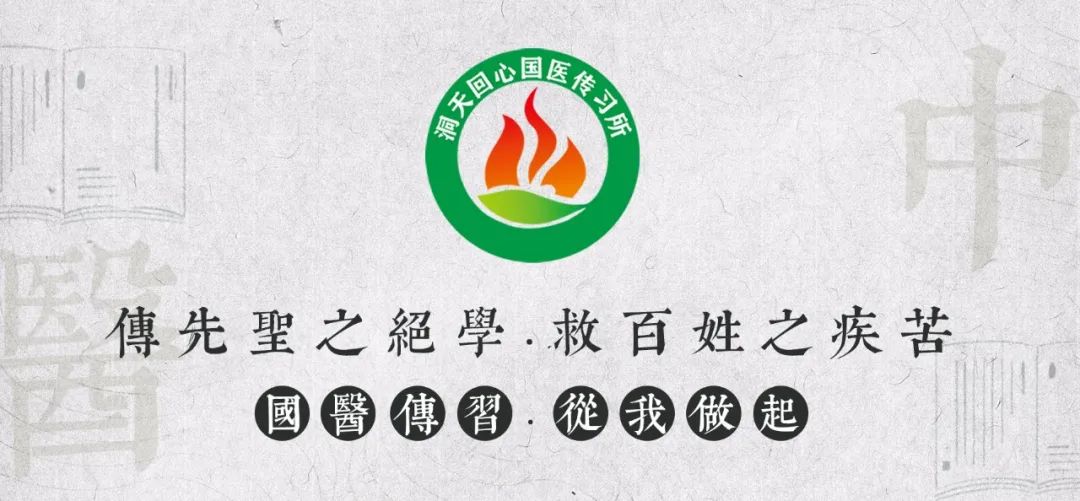
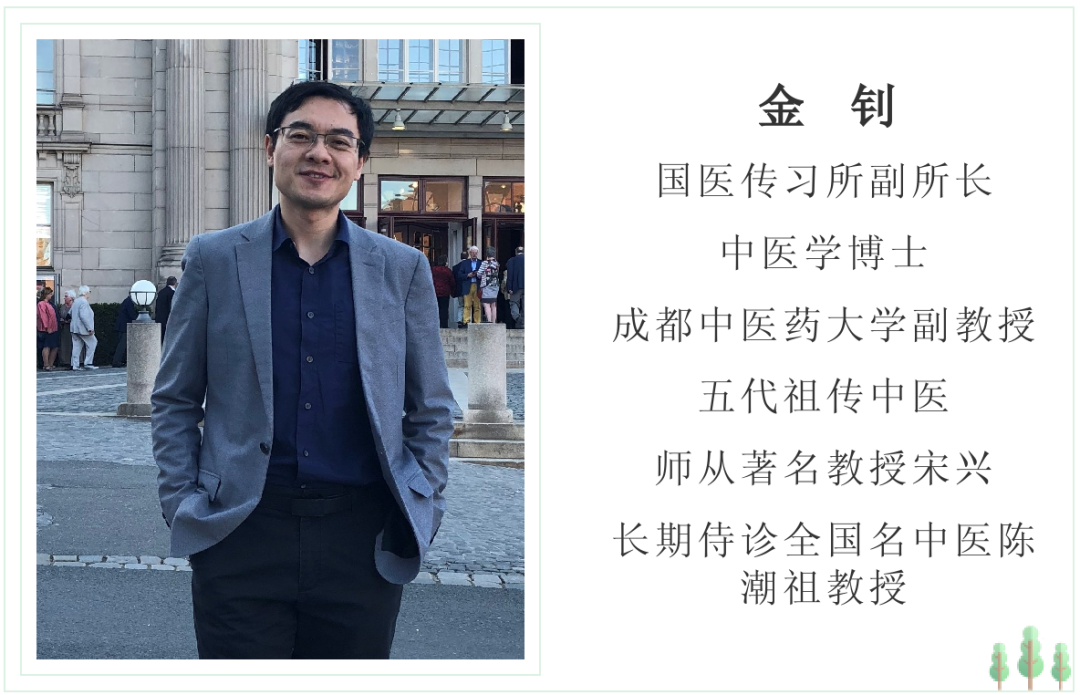
This article’s introduction
When discussing summer dampness and heat, the most important and easily observable sign is the tongue coating. It has been previously explained how to observe the tongue coating. Ultimately, it is essential to emphasize the combination of symptoms, tongue coating, and pulse condition.
1 Typical Damp-Heat Tongue Cases
Now let’s look at several tongue images, although they are not all taken during the summer. We did not specifically take tongue images in the summer; sometimes, the tongue appearances are actually consistent.
Tongue Analysis
For example, this tongue appearance shows a white, thick, and greasy coating, indicating a strong presence of dampness.
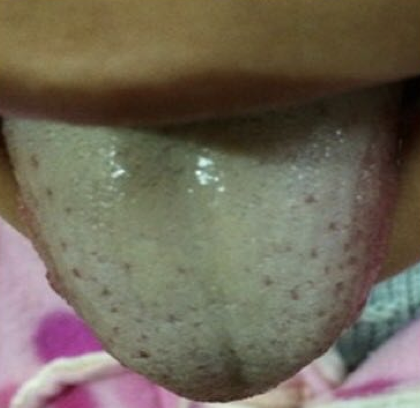

This year, during the COVID-19 free clinic, many tongue coatings of this type were observed, indicating dampness obstructing the membranes and the San Jiao (Three Burners).
Such a tongue coating is particularly contraindicated for the use of heat-clearing herbs in summer; in winter, it is particularly contraindicated to use large amounts of warming herbs to dispel cold.
When this tongue coating appears in summer, it is crucial to understand what it signifies.
The dampness obstruction is too severe, blocking the San Jiao. Even if there is a fever, dampness must be the primary concern, and one must avoid using large amounts of heat-clearing herbs.
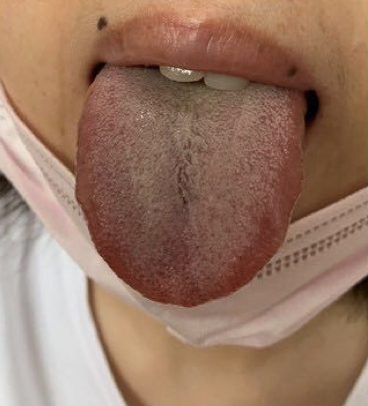

The second tongue coating looks different. It is primarily yellow and greasy but relatively thin, indicating that dampness is not as severe, but it is rapidly transforming into heat, with the tongue surface slightly lacking moisture.
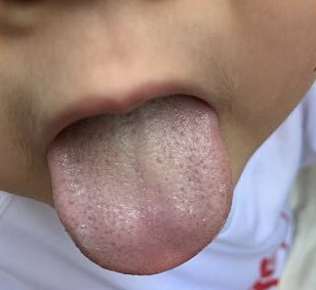

The tongue image above was taken just before class from a child with a fever. The tongue coating is interspersed with yellow and white, not particularly yellow or white.
However, his facial appearance is indicative of steroid use. He has been using steroids extensively and has also been affected by summer dampness. After using steroids, treatment becomes particularly challenging.
Steroids complicate the internal environment of the body, akin to drinking poison to quench thirst, resulting in a vacuous state of the body’s defenses. When dampness or any pathogenic factor invades during summer, the condition tends to be more profound.
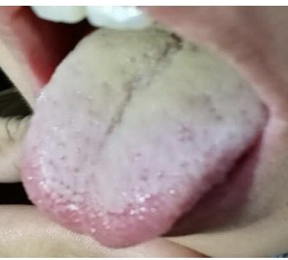

The second tongue image also indicates summer dampness. The entire tongue body is slightly red, with a white greasy coating and some dryness, indicating what condition?
This suggests that heat is relatively strong. As previously mentioned, observing the tongue body helps determine cold or heat; here, heat is more pronounced, with slight transformation into heat, but damp turbidity is heavy. The thickness of the tongue body reflects the severity of damp turbidity. This tongue image shows significant damp turbidity.
Furthermore, the density of the tongue coating indicates the degree of obstruction. This tongue image shows a severe obstruction.
This patient has septicemia, which recurs in summer, and Western medicine has no effective treatment. They came to me for treatment. After severe obstruction, this tongue coating appeared.During treatment, it is crucial to consider and treat with great care.
2 Typical Damp-Heat Pulse Patterns
Regarding pulse patterns, in damp-heat syndrome, the pulse is often irregular.
Damp-heat syndrome can present with both common and special pulse patterns. The common pulse is often floating, slippery, and rapid, but there are many special pulse patterns as well.
In cases of heavier dampness, special conditions may obstruct the flow of Qi, leading to a wiry pulse. A wiry pulse indicates blood stagnation; do you think it is blood stasis? No, it is Qi obstruction. The state of Qi and blood circulation is stagnant, resulting in this condition.
Therefore, in tongue and pulse observations, more emphasis is placed on the tongue. By combining symptoms and tongue observations, one can analyze the pulse. Of course, if the pulse is a common pulse, one can attempt to apply logical reasoning consistently, making diagnosis and treatment very clear.
If the tongue and pulse observations do not match, one must carefully analyze the degree of cold, heat, damp stagnation, and obstruction to determine the treatment method.
3 Integrating the Four Examinations
Even for damp diseases that occur under specific conditions and weather, one must still follow the four diagnostic methods of TCM for differentiation and treatment. One cannot deviate from the principles of TCM differentiation and treatment just because we are discussing summer dampness; it is not appropriate to simply apply a few formulas and handle it casually.
Believing that drinking some lotus leaf tea or taking some Huo Xiang Zheng Qi (Agastache Qi) liquid will suffice is not always correct. While it may work in most cases, such as Huo Xiang Zheng Qi being applicable in many situations, it is not guaranteed.
After being exposed to the sun and feeling overheated, eating some watermelon at home may help; drinking some lotus leaf porridge, mung bean soup, or sour plum soup may relieve summer heat and improve the condition.
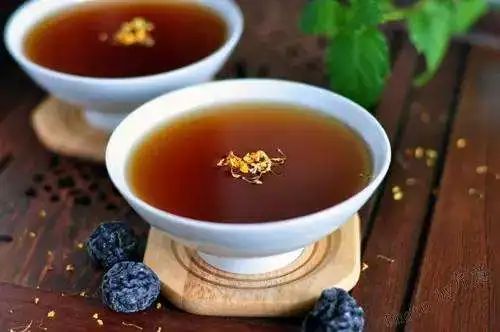
In most cases, this approach may work. However, for doctors sitting at the diagnostic table, it is not sufficient to say that today a patient came in, and based on probabilities, after observing a hundred cases of summer dampness, sixty percent will definitely respond to this method. It is possible that all one hundred patients are unique.
For TCM enthusiasts and the general public, eighty percent of cases may exhibit damp-heat, but if you are unfortunately among that twenty percent, what should you do? Will you be misdiagnosed every time? Therefore, the most important thing is to understand the principles and analyze the situation yourself.
When discussing summer dampness, the most important and easily observable sign is the tongue coating. It has been previously explained how to observe the tongue coating. Ultimately, it is essential to emphasize the combination of symptoms, tongue coating, and pulse condition. Of course, the tongue coating is the most intuitive and objective standard, relatively speaking, providing an accurate indicator for diagnosis.
In conclusion, it is crucial to emphasize: integrate the four examinations.
(This article is based on the lecture recordings of Teacher Jin Zhao, and this article is complete.)
❄This article is an original work by the co-founder of the Guoyi Chuanxi Institute, please indicate the source when reprinting.❄Submissions are welcome at [email protected]Highlights from previous contentWe sincerely invite the first batch of co-founders of the Guoyi Chuanxi InstituteThe pandemic has shown us that traditional Chinese medicine is vital for saving lives and protecting the nation!Read Su Ling’s discussion on the pandemic: developing resilience and understanding the body’s inherent three major medicines. Post-pandemic trends in TCM development. Guoyi Chuanxi Institute’s clinical practice || Application of damp-heat formulas in damp-heat mixed diseases (7). Guoyi Chuanxi Institute’s clinical practice || Prevention of acute altitude sickness (3). Guoyi Chuanxi Institute’s clinical practice || Analysis of classic damp-heat formulas (XI) – San Jiao San. Guoyi Chuanxi Institute’s clinical practice || Wuhan anti-epidemic notes (III) – Unity in Spring. Guoyi Chuanxi Institute’s clinical practice || Home remedies for common cough (IV). Guoyi Chuanxi Institute’s clinical practice || Prevention and treatment of damp-heat diseases (III). Guoyi Chuanxi Institute’s clinical practice || TCM differentiation and treatment of pediatric fever (7) – External pathogens combined with internal injuries. Guoyi Chuanxi Institute’s clinical practice || External treatment methods for neck, shoulder, waist, and leg pain (21). Guoyi Chuanxi Institute’s clinical practice || Polycystic ovary syndrome (6) – Other possible factors causing polycystic ovary syndrome. Guoyi Chuanxi Institute’s clinical practice || Difficult-to-treat nephrotic syndrome (6) – Cases with poor TCM treatment outcomes. Guoyi Chuanxi Institute’s clinical practice || Tongue diagnosis and clinical practice (5) – Dryness of tongue coating. Guoyi Chuanxi Institute’s clinical practice || TCM treatment of recurrent rhinitis (8) – Summary. Guoyi Chuanxi Institute’s clinical practice || TCM treatment of fever (7) – Case studies. Guoyi Chuanxi Institute’s clinical practice || Understanding and self-regulation of menopause (7) – Recommendations for exercise and hormone therapy. Guoyi Chuanxi Institute’s clinical practice || Introduction to the Huangdi Neijing (7) – Commentators and commentaries on the Neijing. Guoyi Chuanxi Institute’s clinical practice || TCM differentiation and treatment of ankle sprains (5) – Treatment of swelling in the non-acute phase. Guoyi Chuanxi Institute’s clinical practice || Prevention and treatment of premature ovarian failure (5) – Treatment methods for premature ovarian failure. Guoyi Chuanxi Institute’s clinical practice || Discussion on Five Element Acupuncture (7) – Treatment principles of Five Element Acupuncture. Guoyi Chuanxi Institute’s clinical practice || Analysis of summer damp-heat syndrome (1) – Causes of summer damp-heat syndrome. Guoyi Chuanxi Institute’s clinical practice || Analysis of summer damp-heat syndrome (2) – The impact of climate on human physiology. Guoyi Chuanxi Institute’s clinical practice || Analysis of summer damp-heat syndrome (3) – The effects of improper diet and lifestyle.

